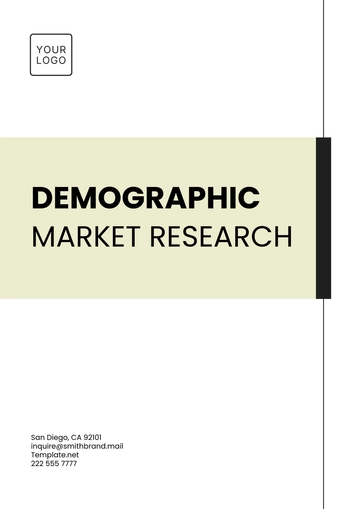Free Demographic Market Research

Prepared by: [YOUR NAME]
Company: [YOUR COMPANY NAME]
I.Introduction
In this report, we explore the segmentation of the market to better understand distinct customer groups and their specific needs. Our analysis is aimed at helping businesses tailor their products and services to target these groups effectively. The findings are based on demographic data projections starting from 2050.
II. Methodology
We utilized a combination of surveys, focus groups, and secondary data sources to gather demographic information. Our sample included over 5,000 respondents across various regions to ensure comprehensive coverage. Data analysis techniques were applied to identify and categorize distinct market segments.
III. Demographic Profile
Our research highlights key demographic factors including age, gender, income, and education level. We found significant variations in preferences and behaviors across different demographic groups. This profile serves as the foundation for segmenting the market effectively.
A. Age:
18-24 years: 20% of the market. This group tends to favor tech innovations and online shopping.
25-34 years: 25% of the market. Known for a strong inclination towards premium and eco-friendly products.
35-44 years: 20% of the market. This group prioritizes family-oriented products and services.
45-54 years: 15% of the market. Prefers high-quality, durable goods with a focus on reliability.
55+ years: 20% of the market. Values traditional products and in-person shopping experiences.
B. Gender:
Male: 48% of the market. Generally shows higher interest in technology and automotive products.
Female: 52% of the market. Displays a stronger preference for health, wellness, and fashion-related products.
C. Income Level:
Low Income (<$30,000): 30% of the market. Sensitive to price and often seeks value-for-money deals.
Middle Income ($30,000-$75,000): 40% of the market. Look for a balance between quality and affordability.
High Income (>$75,000): 30% of the market. Prefers premium, high-end products and services.
D. Education Level:
High School or Less: 25% of the market. Generally prefers straightforward, user-friendly products.
Some College/Associate Degrees: 35% of the market. Shows interest in practical and functional products.
Bachelor’s Degree: 25% of the market. Tends to focus on products with innovative features and high quality.
Graduate Degree: 15% of the market. Values advanced, specialized products and services.
IV. Market Segmentation
The market has been segmented into several distinct groups, each with unique characteristics and needs. For instance, younger consumers (ages 18-34) exhibit a high preference for tech-savvy products, while older consumers (ages 55+) prioritize quality and reliability. Understanding these segments allows for targeted marketing strategies.
A. Consumer Behavior
Analysis of consumer behavior revealed that buying patterns vary significantly by demographic group. Younger consumers are more likely to purchase online, while older consumers prefer in-store shopping experiences. These insights are crucial for developing tailored marketing approaches.
B. Trends and Insights
Emerging trends show a growing demand for personalized products and services across various demographic segments. The shift towards digital platforms and increased focus on sustainability are key factors influencing consumer preferences. Businesses should adapt to these trends to remain competitive.
C. Demand for Personalized Products
D. Shift Towards Digital Platforms
E. Focus on Sustainability
V. Competitive Analysis
Competitors have also segmented their markets, often focusing on high-income and tech-savvy consumers. Our analysis reveals opportunities for differentiation by targeting underserved segments. This insight is valuable for positioning your brand uniquely in the market.
VI. Recommendations
Based on our findings, we recommend focusing on developing targeted marketing campaigns for each identified segment. Additionally, consider product adaptations to meet the specific needs of different demographic groups. Implementing these strategies can enhance market penetration and customer satisfaction.
- 100% Customizable, free editor
- Access 1 Million+ Templates, photo’s & graphics
- Download or share as a template
- Click and replace photos, graphics, text, backgrounds
- Resize, crop, AI write & more
- Access advanced editor
Unlock insights with the Demographic Market Research Template from Template.net. This editable and customizable tool empowers you to tailor your research with ease. Use the AI Editable Tool to analyze and visualize data, ensuring precise and actionable results. Perfect for marketers and analysts seeking efficiency and accuracy in demographic studies.





























